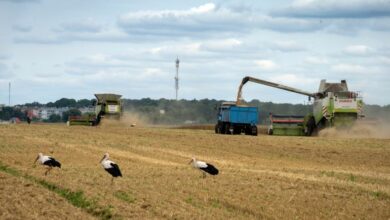Vietnam’s wild elephants get unique ‘ID cards’ in novel conservation plan

Dinh Quan knows just the right spot to hang out on a warm day.
A pool of clean water with fresh grass and some bamboo shoots nearby, preferably with vines hanging within easy reach and showing no signs of being poisonous.Tailing behind Dinh Quan is his junior, Bien Dong, which means “South Sea” in Vietnamese. He is learning the ropes of jungle living from his senior who is at least 15 years old.
The two tusk buddies are wild Asian elephants living in the Dong Nai Biosphere Reserve, a conservation area in Vietnam which includes the Cat Tien National Park, and where an innovative project using “camera traps” is under way to create a unique catalogue of “elephant ID cards” for the area’s much-diminished population of pachyderms.
Pruthu Fernando, chairman of the Sri Lanka-based Centre for Conservation and Research, told Al Jazeera that unlike human society where age and experience confer a degree of respect, among elephants it is size and body mass that decides their social hierarchy.
Fernando, who is an adviser to the United States-based Humane Society International (HSI), said that when elephants reach puberty, at approximately 10 years of age, they drift from the near-constant care of their mothers to join other male elephants in social groups.
That is why Bien Dong and Dinh Quan had buddied up and how a photo of the two trundling towards a waterhole was caught by motion sensor cameras in April. The cameras are part of an elephant conservation project spearheaded by HSI’s Vietnam chapter and local authorities in southern Dong Nai province.
“This is the only project in Vietnam when it comes to elephants, which provides elephant ID cards for each individual,” Nguyen Thi Mai, senior wildlife programme manager at HSI Vietnam, told Al Jazeera.“No one else has done this,” Mai said of the 60 “camera traps” operating in the Dong Nai conservation area, which is located approximately two hours’ drive from Vietnam’s business capital Ho Chi Minh City.
The cameras, inconspicuously attached to the trunks of trees along tracks that animals use to traverse the forest, have sensors that activate when large mammals, like Bien Dong and Dinh Quan, pass by.Images from the cameras are then compiled to create a catalogue of the park’s individual elephants using characteristics such as age, sex, physical traits and their general condition as a means to track their movement and feeding habits, and monitor their health and recovery times if they have been injured or ill.The HSI data compiled to create the unique “elephant ID cards” consists of more than 16,000 images collected during approximately 400 days of camera monitoring from June 2022 onwards.
Analysis of the photographic data appears to show that there are at least 27 elephants in the conservation area, a significant increase from the previous estimate of 14 pachyderms that were thought to form the total population.
The data also indicates that the herd of 27 is in good condition with an average health index score higher than elephants found in Sri Lanka, a country with a significantly larger elephant population and where they inhabit 60 percent of the country’s total land area.
Experts caution, however, that more detailed data needs to be collected to supplement the camera traps in Cat Tien to determine the precise size of the elephant population.HSI’s senior programme manager Mai has more than 15 years’ experience working with wildlife in Vietnam, but even she has not yet seen any of Cat Tien’s elusive elephants in the wild, despite working in the Dong Nai region for four years.
Images from the camera traps are the closest that Mai has come to getting acquainted with the animals in their natural habitat.While camera traps focused on closely identifying elephants are new to Vietnam, they have been used in other countries around the world, such as Thailand, India and Tanzania, as well as elsewhere in Vietnam, but primarily to monitor wild animals at large.
The importance of producing individual identity profiles for Vietnam’s elephants is underscored by the situation nationally, where as few as 130 elephants are still believed to be living wild, a dramatic drop from an estimated 2,000 animals thought to roam the countryside in the early 1980s.
That means that here in Dong Nai province, Dinh Quan and Bien Dong are among Vietnam’s second largest herd of elephants, just behind Dak Lak province in the country’s central highlands region, which has the largest population.
Vietnam’s conservation efforts are limited by resources and expertise, so the HSI camera traps help fill a knowledge gap about elephants while also training local officials in their use, Tran Thi Hoa, the national coordinator of Vietnam’s elephant conservation programme, told a workshop on promoting human-elephant coexistence.High on the coexistence and conservation agenda is the issue of protection, in terms of protecting elephants and rural communities that share the same habitats where elephants love to roam.
Elephants in Nghe An province and Dak Lak in the Central Highlands move internationally across Vietnam’s remote borders with part of Laos and Cambodia. In contrast, elephants in Dong Nai move internally within Vietnam.One method used locally to prevent elephants from stomping out of the national park and conservation area is electric fencing – a subject that some Vietnamese and international experts were split on at last week’s workshop.
Conflict between elephants and residents living near the protected forests of Cat Tien has been reported on by local media over the years, with whimsical headlines such as, “The whole commune lost food and sleep because the Ong Bo knocked on the door.”
Ong Bo, which translates as Mr Bo, is a respectful nickname locals use to refer to elephants who have visited their villages looking for tasty crops and creating mischief.
To prevent those unwanted visits and to also keep humans out of where the elephants roam, a 75km-long solar-powered electric fence encloses part of the reserve.
Tran Dai Nang, a ranger who works for the Dong Nai Forest Protection Department, said there have been hundreds of conflicts reported between local people and the pachyderms in three communes alone in the province, according to surveys conducted from 2020 to mid-2023.










